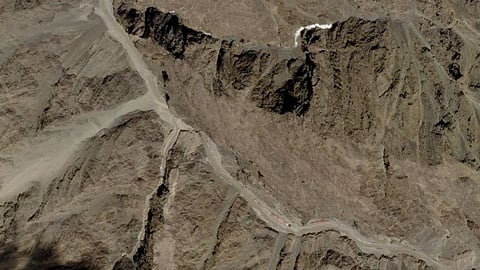De-escalate and disengage, now the buzzwords in India-China standoff, experts say
No danger of India-China war, but limited action by India can’t be ruled out, some feel

Also In This Package
Dubai: The India-China standoff in Ladakh’s Galwan Valley has little prospect of snowballing into a full-scale war between the two Asian powers. According to a section of defence analysts that Gulf News interacted with, while a low-intensity, limited armed action from the Indian side cannot still be ruled out entirely — more so, with Indian Prime Minister Narendra Modi making it public in as many words on Friday that the Indian Army has been given a “free hand” to deal with the situation on the ground — most defence experts still feel that a full-scale war is very much unlikely. Ajai Shukla, a journalist and former colonel with the Indian Army, went a step ahead to say that even a low-intensity retaliation from the Indian side is most unlikely at this point in time.
Gruesome combat
On the night of June 15, in a major skirmish between Indian Army and the People’s Liberation Army (PLA) of China on conflicting territorial claims over what is known as Patrol Point 14 at the Galwan Valley in Ladakh, along the Line of Actual Control (LAC), 20 Indian troops, including a commanding officer, were killed.
While Beijing is yet to release any details about casualty figures on its side, reports in the India media said the number of Chinese soldiers killed or injured in the gruesome hand-to-hand combat could be around 43.
Also Read: India and China are actually far from a war
Also Read: India and China must defuse border tension
This was the first incident of major cross-border bloodshed between the two countries since 1975. In keeping with a bilateral agreement, neither side has resorted to the use of firearms at the border since 1967, but according to reports, the severity of the June 15 conflict -- which was primarily hand-to-hand combat, using crude weapons such as iron rods, stones and sticks with barbed-wire and nail head wrappings -- was something unheard-of in border disputes between the two nuclear-armed nations in four-and-a-half decades.
‘Diplomatic and military dialogue’
Sharing his views with Gulf News from New Delhi on Saturday morning, Shukla explained: “India has already signalled that it prefers to resolve this situation through diplomatic and military dialogue, rather than through armed combat. It has engaged in talks between senior military officers in an attempt to de-escalate the situation and to disengage forces.”
Reacting to queries from Gulf News, Shashank Joshi, defence editor with The Economist, put things in perspective regarding the contesting claims made by Beijing and New Delhi over territory that lies on either side of what is known as the Line of Actual Control (LAC) between India and China. The LAC itself is not a clearly delineated topographical or military marker, with several areas along this divider still remaining fuzzy, where Indian and Chinese claims overlap, thereby resulting in border standoffs between the two sides from time to time.
Patrol Point 14
Commenting on the current fluid situation along the LAC and claims and counter-claims of sovereignty on either side of it, Joshi said: “Most of the Galwan Valley — which is the current flashpoint between India and China — does indeed lie beyond India’s traditional perception of the Line of Actual Control. The main dispute appears to be over the confluence of the Shyok and Galwan Rivers, including the heights above them. One particular point — Patrol Point 14 — seems to be especially sensitive.”
Asked to comment on how realistic are the chances of the current situation snowballing into a full-scale war, professor Bharat Karnad from the Centre for Policy Research, New Delhi, and a national security expert, told Gulf News: “If the PLA fails to withdraw from the Galwan Valley, there’s a possibility of a Kargil-type limited war to vacate the Chinese presence from that sector.”
‘Neither side wants to enter into a conflict’
Further explaining the reasons behind why a major military conflict is unlikely between India and China at the moment, Joshi commented: “Both sides have said they want to return to a disengagement agreement that they had reached on June 6. The terrain makes it hard to conduct major military operations and neither side wants to enter into a conflict when they each have major COVID-19 and economic issues to deal with. A longer stand-off is therefore likely now.”
However, Shukla was quite categorical in ruling out even a limited military action from the Indian side as a retaliatory measure against 20 Indian soldiers dying at the hands of the PLA. Shukla said: “The prospect of armed combat and counter-measures or retaliatory measures seems remote at the moment.”
‘Consolidating status quo’
The June 15 skirmish between Indian Army and the PLA took place in spite of an agreement between the two sides, that was arrived upon during major general-level talks on June 6, in which the Chinese side had reportedly agreed to push back from Patrol Point 14. So, does that entail a failure of military-level talks to defuse the tension? Reacting to the query, Karnad said: “These military-level talks never amount to much. At best they consolidate the status quo of the moment.”
Asked about the relative strengths and weaknesses of the two sides in a high-altitude battlefield, such as the one in Galwan Valley, Joshi said: “In the east [of Ladakh], China probably has more troops acclimatised and ready to fight. In the west, however, it is more balanced. Some experts also think that Chinese fighter planes taking off from Tibet would not be able to carry as much fuel or as many weapons, because of the altitude factor.”
‘Strained supply line’
Explaining the point further, Karnad said: “The disparity in the military power between the two countries is real. So India will be unable to sustain a long war with China. However, having said that, the Chinese forces are also handicapped by a strained supply line in a high-altitude battlefield.”
With Indian Prime Minister Narendra Modi categorically declaring that there has neither been any incursion into Indian territory nor has any Indian border post been overrun by anyone — the controversy over the comment notwithstanding — the disengagement and de-escalation dice has already been rolled, experts say.
Sign up for the Daily Briefing
Get the latest news and updates straight to your inbox








